Acer Iconia W4 review: a big upgrade to a small Windows tablet

Acer's Iconia W3 wasn't quite the best introduction to 8-inch Windows tablets; we liked it, but its subpar display and modest performance kept it from being stellar. Give credit to the company for quickly learning from its mistakes, though. Less than a year later, the company has released the Iconia W4, and it fixes those earlier gripes even as the price has dropped below $300 as of this writing. In theory, it's a home run. However, Acer is no longer the only game in town -- the W4 has to compete against a crowd of small Windows slates that promise similar bang for your buck. We think the W4 still fares well in this pack, although it won't always be a dream machine. Read on and you'll understand why.
Hardware
If you only gave the Iconia W4 a cursory glance, you would almost think that you'd picked up the W3 by accident. Outside of the repositioned logos and metal-colored plastic ("smokey gray," in Acer-speak), the newer device is a dead ringer for its 2013-era ancestor. That's not necessarily a bad thing, although it could stand to be better: While the curvy design is comfortable to hold and generally well-built, it's not exceptionally grippy. We'd prefer the rubbery back of Dell's Venue 8 Pro for one-handed tablet use. The W4's front-facing Windows key is much more convenient than the Venue's side button, mind you. For many, the real affronts may be the giant, tacky Intel Inside and Windows 8 stickers slapped on the back. Couldn't you have chosen some subtler decals, Acer?
The newer Iconia is undoubtedly more portable than the W3. Despite its upgraded internals, the tablet weighs 0.92 pound -- much lighter than its 1.1-pound predecessor. It's ever so slightly thinner, too, at 0.42 inch thick. The W4 is still noticeably chunkier than 8-inch tablets like Apple's iPad mini with Retina display or Samsung's Galaxy Tab Pro 8.4, but the difference is small enough that I didn't notice it while reading or watching videos. Even so, the Iconia is heavy compared to most 8-inch Windows hardware; the Venue 8 Pro, ASUS' VivoTab Note 8 and Lenovo's Miix 2 are a tad lighter. At least it's not the heaviest: The Toshiba Encore manages to top them all.
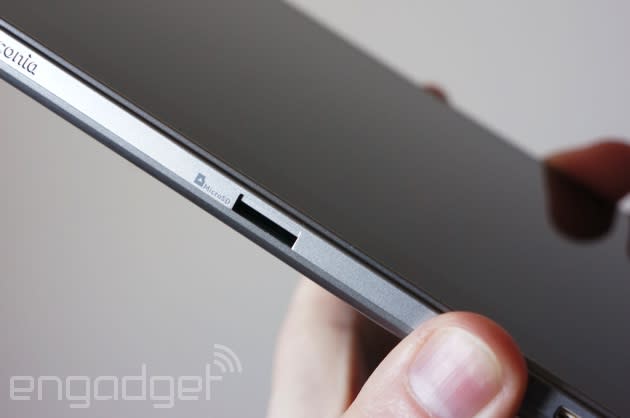
Not much has changed in the way of external features. You'll find the familiar micro-USB port, stereo speakers and headphone jack on the bottom. Switch to the right-hand side and you'll see a microSD card slot, a micro-HDMI video port (notably missing on Dell's tablet), a volume rocker and one of two microphones. The only conspicuous functional change on the outside is the backside camera: While we've seen the 2-megapixel front camera before, Acer has replaced the W3's paltry 2MP rear shooter with a 5MP unit. That's a lower res than the 8-megapixel sensor in the Encore, but it at least means you'll get reasonably sharp photos. Inside, there's still 32GB or 64GB of storage.
Unsurprisingly, you won't get any accessories in the box with such a low-cost device. Serious typists can plunk down $80 for the official Bluetooth keyboard dock, which remains unchanged from last year. We didn't test the peripheral this time around, but it's almost mandatory if you expect to write often. It's safe to say that you'll finish that big essay much sooner with full-size hardware keys instead of typing on an 8-inch glass pane.
Display and sound
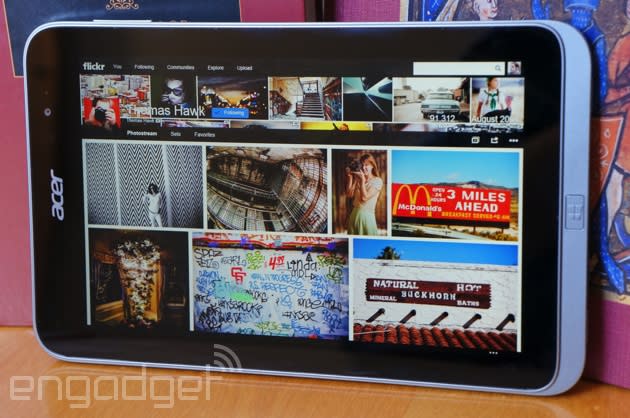
Let's not beat around the bush: The Iconia W4's 8.1-inch screen is a quantum leap over the W3's. Where the older tablet's TN-based panel would wash out when you weren't looking at it head-on -- in other words, most of the time -- the IPS LCD in the W4 is color-rich from virtually any angle. It's easier to read in less-than-ideal lighting conditions, too, thanks to a gapless design that eliminates a lot of glare (though certainly not all of it). Acer has at least caught up with its Windows rivals on the quality front, and those who'd avoided the W3 due to its screen may want to take a second look.
With that said, this isn't the best display we've seen at this size. Although the W4's 1,280 x 800 resolution is sharp enough for most media tasks, it's hard not to wish for the crisper visuals of either similarly priced mobile OS tablets like the Galaxy Tab Pro 8.4 (2,560 x 1,600) or a higher-end Windows tablet like Lenovo's ThinkPad 8 (1,920 x 1,200). Those mobile OS devices probably aren't on your radar if you're shopping for a Windows tablet, but it would be nice to have their beauty alongside the W4's brawn. You also won't get a digitizer like that on the ASUS or Dell tablets, so you'll have to make do with a relatively crude third-party stylus if you want to draw.
Acer could certainly stand to borrow some audio hardware from its competitors. The speakers on the Iconia are just as weak as on the W3 -- even at full volume, they're only loud enough for a quiet room. You wouldn't want to watch movies with the W4 in a busy house.
Software
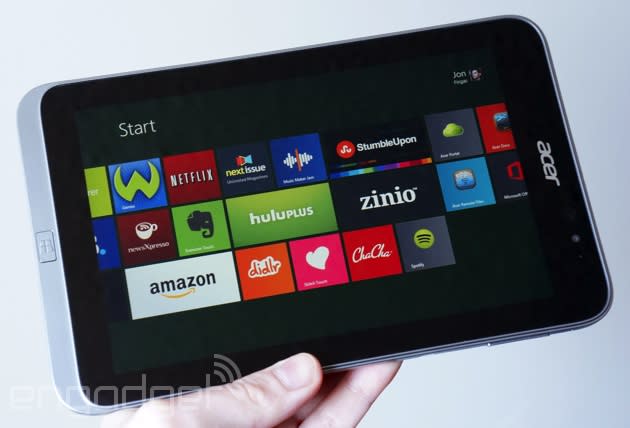
The Iconia W3 was one of the earliest showcases for Windows 8.1, so the experience of using that OS on the W4 will seem uncannily similar. Not that you'll mind if you like Microsoft's modern interface. Some of Windows 8.1's features were built with diminutive tablets in mind, including smaller Live Tile sizes (to fit more on screen at once), access to the camera from the lock screen and more keyboard shortcuts. The platform's multi-window snap mode isn't as useful here as it would be on larger-screened hardware, but it's still appealing to have a chat client open while you browse the web, or to check email while you catch up on TV shows. Most mobile platforms can't juggle multiple active apps very well (see Samsung's TouchWiz) or at all, so you'll be happy with Windows if you prefer to run more than one app at a time.
The modern Windows app ecosystem is also reasonably healthy. Although you won't find some of the bigger mobile games and apps (think Threes or Instagram), the odds are high that there's touch-native software available to do what you want. Hulu, Netflix and the major TV networks have Windows 8.1 titles; you'll also find reading apps like Amazon Kindle and Flipboard, while Nokia's Here Maps provides a solid navigation option when you're on WiFi. Heck, you can even fire up VLC to play less common media formats. Just be aware that major developers like Apple, Mozilla and Valve may never support the interface; you likely won't get a finger-friendly version of iTunes or Steam, for instance.
These absences won't matter as much when you have full access to the traditional Windows desktop, although having this fallback isn't as ideal as it sounds. Simply put, the older interface doesn't elegantly shrink down to an 8-inch display. You'll often find yourself pressing the wrong button or obscuring a text input box with the virtual keyboard. If you expect to spend a lot of time in the classic interface on the W4, we'd strongly suggest using a mouse and keyboard -- you'll get around considerably faster.

No matter which front end you prefer, there will be an abundance of apps from Acer, Microsoft and a wide range of third-party developers. Acer offers 10 titles of its own for app shopping, backups, media playback and sync, while Microsoft Office is here if you need to get work done. Venture into the third-party collection and there's even more: You'll get Amazon shopping, ChaCha, Didlr, Evernote, eBay, Hulu Plus, Kindle, Music Maker Jam, a Nero backup suite, Netflix, NewsXpresso, Next Issue, Norton Online Backup, Skitch, Spotify, StumbleUpon, WildTangent and Zinio. Frankly, the selection is overkill. How is a newcomer going to recognize many of these apps, let alone find uses for more than a few of them? We're all for giving tablet buyers a head start, but we'd prefer a more focused, easily understood software lineup.
Performance and battery life
Device | PCMark7 | 3DMark06 | 3DMark11 | ATTO (top disk speeds) |
|---|---|---|---|---|
Acer Iconia W4 (1.33GHz Intel Atom Z3740, Intel HD graphics) | 2,538 | 2,089 | E340 / P211 | 173 MB/s (reads); 48 MB/s (writes) |
Acer Iconia W3 (1.8GHz Intel Atom Z2760, Intel HD graphics) | 1,447 | N/A | N/A | 84 MB/s (reads); 35 MB/s (writes) |
ASUS Transformer Book T100 (1.33GHz Intel Atom Z3740, Intel HD graphics) | 2,461 | 2,113 | E338 / P209 | 123 MB/s (reads); 58 MB/s (writes) |
Dell Venue 8 Pro (1.33GHz Intel Atom Z3740D, Intel HD graphics) | 2,343 | 1,986 | E299 / P164 | 86 MB/s (reads); 45 MB/s (writes) |
Thanks to timing, last year's Iconia W3 ended up with a relatively creaky dual-core, 1.8GHz Atom Z2760 processor at its heart. That was certainly enough for common tasks, but it left the W3 lagging as tablets arrived in the fall sporting Intel's much-improved Bay Trail architecture. Kudos to Acer for getting up to speed in short order, though: The W4 is running the same quad-core, 1.33GHz Atom Z3740 as the latest budget Windows slabs. The 2GB of RAM hasn't changed, although that's both par for the course and enough to handle the lightweight apps you're likely to be running.
You may not notice a major difference in typical 2D programs, but that's largely because Windows 8.1 is forgiving with low-end devices. The W3 was already zippy when navigating the OS and playing media, so throwing more cores at these basic duties doesn't make a difference. However, it doesn't take much digging to see some tangible performance gains. The newer Iconia completes the SunSpider web browsing test in a brisk 402ms, versus more than 720ms for an Atom Z2760-based slate; the W4's PCMark7 score is a whopping 75 percent higher. We wouldn't upgrade from a W3 just for this newfound speed, but it's a large enough boost that we'd rather buy a new W4 than a refurbished W3.

Some of that added get-up-and-go likely comes from a massive improvement to the solid-state storage. The Samsung flash memory inside the W4 is the fastest we've seen in a low-cost Windows tablet, and almost twice as quick as what the W3 used. You won't wait long for most apps to start, and the boot time has been cut from a so-so 15 seconds to less than eight. The Iconia may not have an edge in processing power over its competition, but the reduced loading times will make it feel a little more powerful.
Don't buy one as an ultraportable gaming rig, though. We could play an older release like Half-Life 2 at a smooth frame rate using low-to-medium settings, as we could on the Dell Venue 8 Pro, but the quad-core Atom chip and its Intel HD graphics won't cut it for visually intensive games like BioShock Infinite. You're best off with 2D games or ports of mobile 3D content. At least the Iconia W4 is fairly cool to the touch; even when running HL2, the tablet only got mildly warm.
Tablet | Battery Life |
|---|---|
Acer Iconia W4 | 9:50 |
Microsoft Surface 2 | 14:22 |
Apple iPad Air (LTE) | 13:45 |
Nokia Lumia 2520 | 13:28 (tablet only) / 16:19 (with dock) |
Apple iPad mini | 12:43 (WiFi) |
Apple iPad mini with Retina display | 11:55 (LTE) |
Apple iPad (late 2012) | 11:08 (WiFi) |
ASUS Transformer Book T100 | 10:40 |
Apple iPad 2 | 10:26 |
Samsung Galaxy Note Pro 12.2 | 10:04 |
Apple iPad (2012) | 9:52 (HSPA) / 9:37 (LTE) |
Nexus 7 (2012) | 9:49 |
Microsoft Surface RT | 9:36 |
Apple iPad | 9:33 |
ASUS Transformer Prime Infinity TF700 | 9:25 |
Acer Iconia W3 | 9:21 |
Samsung Galaxy Tab 2 10.1 | 8:56 |
Sony Xperia Tablet Z | 8:40 |
Toshiba Excite Write | 8:13 |
Galaxy Tab 2 7.0 | 7:38 |
HP Slate 7 | 7:36 |
Nexus 10 | 7:26 |
Dell Venue 8 Pro | 7:19 |
Samsung Galaxy Note 8.0 | 7:18 |
Nexus 7 (2013) | 7:15 |
Samsung Galaxy Tab Pro 8.4 | 7:13 |
Samsung Galaxy Tab 3 10.1 | 6:55 |
HP SlateBook x2 | 6:34 (tablet only) / 8:49 (keyboard dock) |
Thankfully, the higher-powered processor doesn't hurt battery life. Acer estimates eight hours of non-stop video on the W4, as it did for the W3, but we managed nine hours and 50 minutes in our own looping video test before the tablet conked out -- half an hour more than we got from last year's model. That's with the screen locked at 65 percent brightness, and WiFi periodically fetching both email as well as social network updates. In real-world terms, we could go for about three days of moderate browsing, email, music streaming and socializing. Standby mode doesn't drain much power, either, so you won't always have to plug in if you have a few hours' charge left over at the end of the day. Although the Iconia won't outlast the Transformer Book, newer Windows RT slates and the latest iPads, it's in another class compared to the Miix 2 and Venue 8 Pro. Just watch out for the Encore; it may humble the W4 if it lives up to Toshiba's claim of 14 hours of battery life.
A couple of notes are due regarding that 5-megapixel camera. Its picture quality isn't anything to write home about, as with many tablet cameras -- it's too noisy in low light, doesn't produce vibrant colors in daylight and has no major options outside of a panorama mode. However, it does have a party trick. Like some recent smartphones, pressing the shutter button will take a burst of photos (60 per second) and let you pick one ideal shot to save for posterity. You won't want to go on photo safaris with the Iconia, but that best-photo option is handy if your subjects won't stay put.
Configuration options
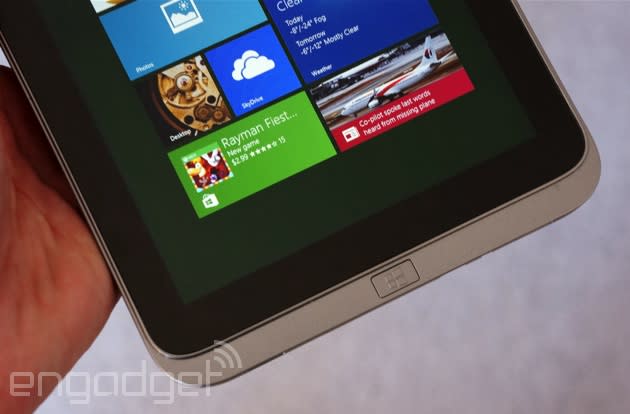
Acer offers just two choices of Iconia W4 models, but we won't complain too loudly given the appealing prices. You can snag a 32GB model for under $300, or at least $80 less than an equivalent W3 cost when new. Your other option, the 64GB variant, is still less expensive than the 32GB original at $350. There are even better deals available if you hunt around; we've seen the 32GB W4 discounted to $250 at Amazon. Of the two W4 variants, you'll want to splurge on the 64GB device so long as you're not strapped for cash. It didn't take long for us to chew up half of the 52GB of free space, and that was after installing a handful of benchmark tools, games and productivity apps. The 32GB Iconia W4 is best for those who tend to keep only small files (think Office documents) and get most of their content from the cloud.
As we mentioned, the only real official W4 accessory is the $80 Bluetooth keyboard. There's a chance that cases and other W3-oriented add-ons will work, but we'd recommend trying these older accessories before you buy to avoid any rude surprises.
The competition

When the Iconia W3 arrived, it was an easy choice; there weren't any other small Windows tablets on store shelves. Flash forward to early 2014, though, and the Iconia W4 is facing a glut of competition. There isn't even much to separate the W4 from the pack at first blush. As a general rule, you can expect each of these devices to carry a 1,280 x 800 screen, a 1.33GHz Atom processor, 2GB of RAM, at least 32GB of storage and an official $300 price point. They even go on sale at similar prices (you can pick up either the W4 or Venue 8 Pro for $250, as an example). Does Acer have a chance of standing out?
Yes, actually. The W4's most obvious competitor is the Dell Venue 8 Pro, but it's not as strong a contender as you might think. Acer typically comes out ahead with a longer-lasting battery, micro-HDMI video and a higher-resolution front camera. Dell's main weapon is its pen support; if you like to take handwritten notes, the Venue will make more sense. We could also see some customers preferring Dell's more grippable chassis, although it's not so important that we'd ignore other factors.
Other compact Windows tablets don't usually fare much better. At its official $329 price, ASUS' VivoTab Note 8 isn't easy to justify unless you crave Wacom pen input. Lenovo's Miix 2 is lighter at 0.77 pounds, but its seven-hour claimed battery life and lack of video output may take it off your list; it no longer has a meaningful price advantage. The one competitor that catches our eye is the Toshiba Encore. With an 8-megapixel rear camera, micro-HDMI and that extra-long runtime, it's potentially an ideal tablet if you can find a good bargain (it's $270 at Newegg as we write this). We'll be testing the Encore soon, so keep your eyes peeled.
If money isn't an object, there's the Lenovo ThinkPad 8. It costs at least $100 more than the Iconia W4, but you also get more -- a faster processor, a higher-resolution screen, premium build quality and a sharper camera. There are options for 4G data and up to 128GB of storage, too. While we've yet to test the ThinkPad beyond a hands-on, you'll want to at least consider it if you're looking for the best possible 8-inch Windows device.
Wrap-up
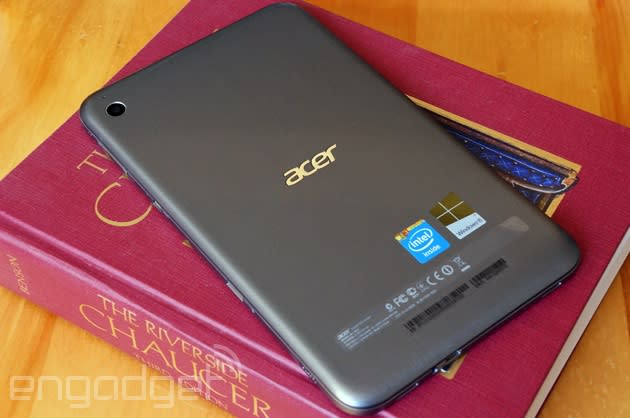
More Info
Going into this review, we were skeptical that Acer could fend off its challengers. And yet, for the most part, it has. The Iconia W4 has the screen we were looking for the first time around, better battery life than some of its peers and the performance to handle most apps with grace. As long as you're a fan of Windows 8.1 to start with, the big knocks against the W4 are limited to its relative heft, poor speakers and lack of native stylus support.
Having said this, the Iconia W4 doesn't break any molds. The battery and display are good, but not spectacular; you'll want to look to the Toshiba Encore for a longevity champion. The cameras won't have you ditching your smartphone, and mobile OS tablets at this size still tend to have both higher-resolution screens and wider native app selections. Even so, the W4 represents a lot of tablet for the money. If you're intrigued by running desktop-grade software on a miniature tablet, it's worth checking out.
Daniel Orren and Edgar Alvarez contributed to this review.
































